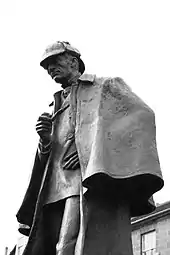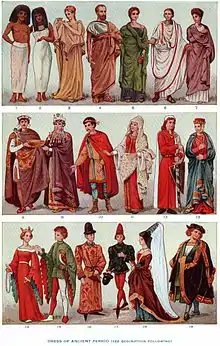Inverness cape
The Inverness cape is a form of weatherproof outercoat. It is notable for being sleeveless, the arms emerging from armholes beneath a cape. It has become associated with the fictional detective Sherlock Holmes.
History
The garment began in the 1850s[1] as the Inverness coat, an outer-coat with sleeves covered by a long cape, reaching the length of the sleeve.[lower-roman 1] By the 1870s, the cape was divided in two, and a small "capelet"-like "wing" on each side was sewn into the side seams, not taken across the back.[2] In the 1880s, the sleeves were removed entirely, and the armholes were cut away beneath the cape to form the Inverness cape.[2][3]
The fronts of the coat may be finished in either of two styles: in one, the more formal, the topcoat is finished with short lapels and the capes are set back behind them.[4] In another style, there are no lapels. A simple fall collar with a tall stand is used, the capes buttoning across.[5] These were also favoured for less formal wear, particularly by coachmen and cab drivers, who needed free movement of their arms. Indeed, this style is usually called a "coachman's cape."
The Inverness cape is a water-repellent garment. The commonly held image of the cape as worn by Holmes is one made of tweed, specifically in a grey houndstooth pattern. However, more modest capes, made of nylon or twill-weave fabrics and usually black in colour, are commonly used by members of pipe bands.
Highland dress

Even though a wide variety of coats, overcoats, and rain gear are worn with Highland dress to deal with inclement weather, the Inverness cape has come to be almost universally adopted for rainy weather by pipe bands the world over, and many other kilt wearers also find it to be the preferable garment for such conditions. Unlike most raincoats or other conventional overcoats, the Inverness cape has no sleeves. Instead, it has wide-cut armholes in the sides to accommodate the arms. This enables the wearer to access a sporran without unbuttoning and opening up the cape. The opening in the side is covered by a short cape, which can be buttoned up in the front.
In popular culture

Arguably the most famous example in fiction, Arthur Conan Doyle's famous detective Sherlock Holmes is often associated with the Inverness cape.[3] In the Holmes novels, Holmes is described as wearing an Ulster. Holmes's distinctive look, which was usually complemented with a deerstalker cap and a calabash pipe, is a composite of images, originally credited to illustrator Sidney Paget. But as adapted to the stage by the actor-playwright William Gillette, Holmes did not wear a cape-coat at all, and the origin of the calabash pipe is something of a mystery, although it might have had something to do with Gillette's introduction of a full-bend briar pipe for his performances. Paget had depicted Holmes as smoking straight pipes, exclusively.
Be that as it might, the cape-coat, the deerstalker, and the calabash pipe were already associated with Holmes by the 1930s, chiefly in the United States, but the image became definitive with the first two films in which Basil Rathbone appeared on-screen as Holmes, produced for 20th Century Fox in 1939.[lower-roman 2]
August Derleth's Solar Pons, essentially Sherlock Holmes with a different name and living in Praed Street in the 1920s, also wears an Inverness.[6]
Inverness capes are worn by characters in many Western and Spaghetti Western films, such as Lee Van Cleef's character in For a Few Dollars More and Gianni Garko in the Sartana series.
In the 1970s of the long-running series Doctor Who, the Third Doctor (Jon Pertwee), frequently wore an Inverness cape over his dandy suits.
The vampire Barnabas Collins (as portrayed by actor Jonathan Frid) wore an Inverness cape on the cult classic Gothic soap opera Dark Shadows.
The 2001 film adaptation of the absurdist play Waiting for Godot has landlord Pozzo (played by Alan Stanford) wearing an Inverness cape, symbolising the Protestant Ascendancy landlords of Ireland.
Still worn in the United Kingdom, the Inverness cape is often made of heavy Harris tweed of plaid and checked designs. It is usually worn for country wear. Lighter weight black cape-coats are more associated with formal evening attire.
Popular urban fantasy hero Harry Dresden of The Dresden Files by Jim Butcher replaced his trademark duster with an Inverness coat in Cold Days, the 14th book of the series.
Steampunk fashion has revived the wearing of the Inverness cape to a limited extent.[3]
See also
References
- In comparison, the Ulster coat is similar, but the cape of an Ulster reaches only to the elbows.
- In the Holmes short stories that were published in The Strand Magazine, Paget had depicted Holmes wearing a plaid Ulster, paired with a Bowler, not the deerstalker, in "The Musgrave Ritual" and "The Blue Carbuncle." In the text of "The Adventure of Silver Blaze" and "The Boscombe Valley Mystery", Holmes is not described as wearing an Inverness but a "long grey travelling cloak" depicted by Paget as an overcoat with a hood. See File:Sherlock Holmes Paget.jpg
- Waugh, Norah (1964). The Cut of Men's Clothes. p. 143. ISBN 1138870552.
- Davis, R.I. (1994). "Topcoats". Inverness caped topcoat. Men's Garments: 1830-1900 (2nd ed.). Players Press. pp. 122, 140–143. ISBN 0-88734-648-0.
- "1850s-1900s Inverness or "Sherlock" Cape". Patterns for Historical Clothing. Reconstructing History. RH940.
- Davis, Men's Garments, p. 140, fig. 29
- The Delineator. October 1892.CS1 maint: untitled periodical (link)
- Derleth, August (1974). Regarding Sherlock Holmes... #1/The Adventures of Solar Pons. New York, N.Y.: Pinnacle Books. p. 185. ISBN 0-523-00477-X.



